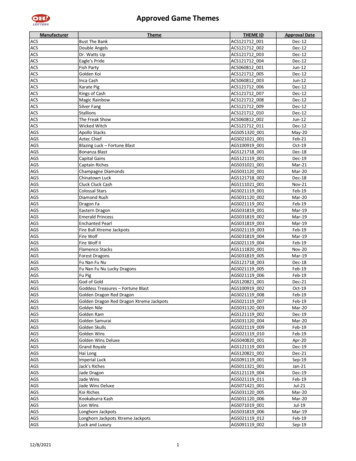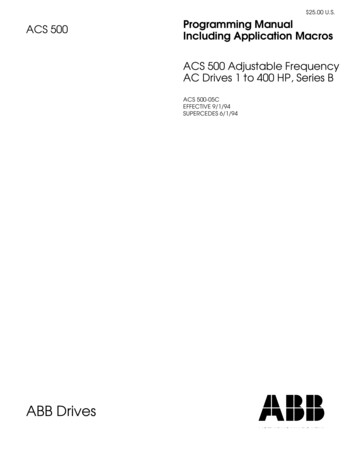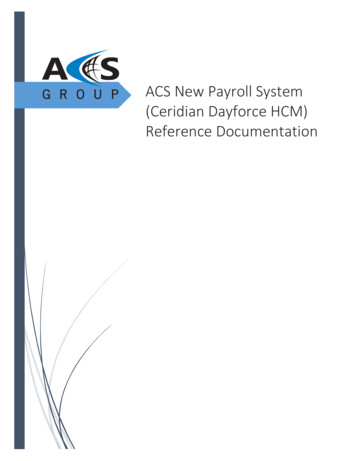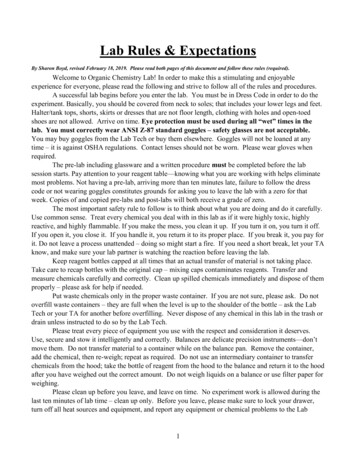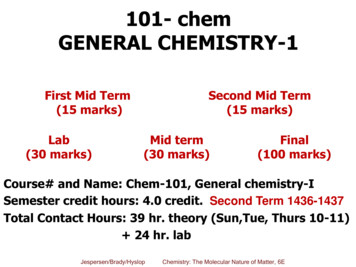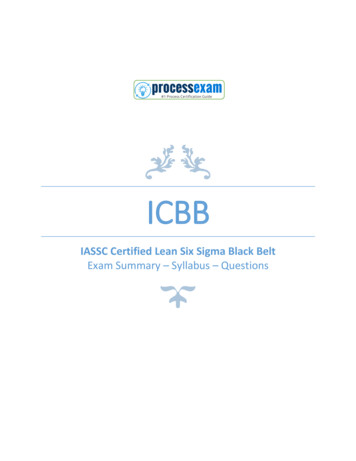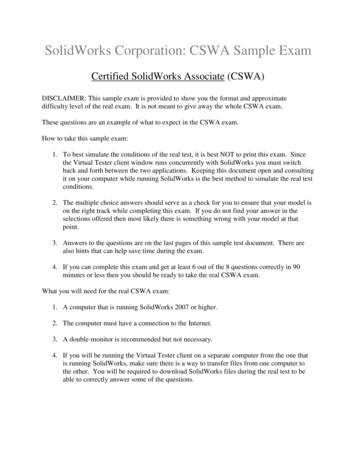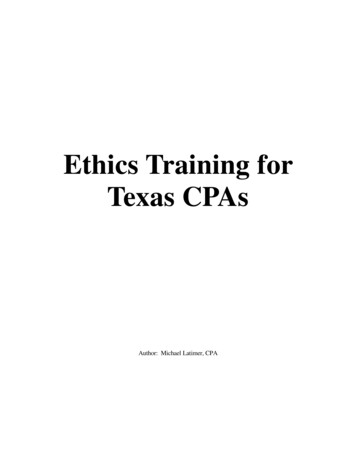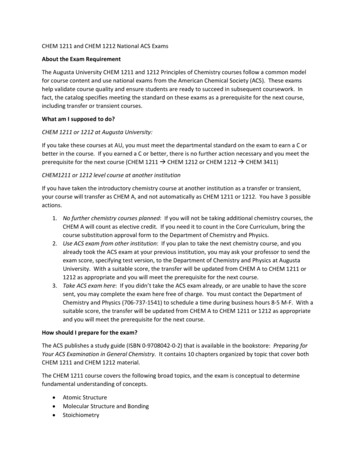
Transcription
CHEM 1211 and CHEM 1212 National ACS ExamsAbout the Exam RequirementThe Augusta University CHEM 1211 and 1212 Principles of Chemistry courses follow a common modelfor course content and use national exams from the American Chemical Society (ACS). These examshelp validate course quality and ensure students are ready to succeed in subsequent coursework. Infact, the catalog specifies meeting the standard on these exams as a prerequisite for the next course,including transfer or transient courses.What am I supposed to do?CHEM 1211 or 1212 at Augusta University:If you take these courses at AU, you must meet the departmental standard on the exam to earn a C orbetter in the course. If you earned a C or better, there is no further action necessary and you meet theprerequisite for the next course (CHEM 1211 CHEM 1212 or CHEM 1212 CHEM 3411)CHEM1211 or 1212 level course at another institutionIf you have taken the introductory chemistry course at another institution as a transfer or transient,your course will transfer as CHEM A, and not automatically as CHEM 1211 or 1212. You have 3 possibleactions.1. No further chemistry courses planned: If you will not be taking additional chemistry courses, theCHEM A will count as elective credit. If you need it to count in the Core Curriculum, bring thecourse substitution approval form to the Department of Chemistry and Physics.2. Use ACS exam from other institution: If you plan to take the next chemistry course, and youalready took the ACS exam at your previous institution, you may ask your professor to send theexam score, specifying test version, to the Department of Chemistry and Physics at AugustaUniversity. With a suitable score, the transfer will be updated from CHEM A to CHEM 1211 or1212 as appropriate and you will meet the prerequisite for the next course.3. Take ACS exam here: If you didn’t take the ACS exam already, or are unable to have the scoresent, you may complete the exam here free of charge. You must contact the Department ofChemistry and Physics (706‐737‐1541) to schedule a time during business hours 8‐5 M‐F. With asuitable score, the transfer will be updated from CHEM A to CHEM 1211 or 1212 as appropriateand you will meet the prerequisite for the next course.How should I prepare for the exam?The ACS publishes a study guide (ISBN 0‐9708042‐0‐2) that is available in the bookstore: Preparing forYour ACS Examination in General Chemistry. It contains 10 chapters organized by topic that cover bothCHEM 1211 and CHEM 1212 material.The CHEM 1211 course covers the following broad topics, and the exam is conceptual to determinefundamental understanding of concepts. Atomic StructureMolecular Structure and BondingStoichiometry
States of Matter and Intermolecular ForcesPeriodicityThe CHEM 1212 course reinforces and builds upon the 1211 topics and further covers the additionaltopics below. While the test requires understanding of topics, the test is less conceptual. stry/RedoxAs the published ACS Study Guide articulates, chemistry knowledge should be more than sets offormulas and techniques. Rather, it is a coherent set of knowledge that enables comprehension of thesubmicroscopic (chemical) world. As such, the ACS tests seek to uncover such genuine understanding.CHEM 1211 Example QuestionsThere is an emphasis on conceptual questions. The actual exam will be multiple choice. The belowquestions are guaranteed not to be on the exam.Atomic Structure1. How many protons, neutrons and electrons are in each of the following?56Fe39 K79Br‐αβ‐2. Match the quantum number (column 1) with what it represents (column 2).There may be more than one answer in column two that is correct and column 2 answers maybe used more than once or not at all.Column 1Principal (n)Angular momentum (l)Magnetic (ml)Spin (ms)Column 2Number of nodesShape of orbitalSize of orbital (distance orbital extendsfrom the nucleus)Degenerate energiesIncreasing potential energyDirection electron is spinning3. Elemental iodine is a purple solid with naturally occurring iodine having the properties shown in thetable.PropertyMelting point114 degrees C
SolubilityReactivityFormula weight (ormolecular mass)Soluble in hexane,poorly soluble in waterOxidizing agent254 g/molWhich properties will have a significant, noticeable change when the iodine has each adjustment below:a. A neutron is removed from each iodine atomb. A proton is removed from each iodine atomc. An electron is removed from the iodine molecule4. Name 2 experiments that support the idea that electrons have particle‐wave duality.Molecular Structure and bonding1. For each of the following formulas:1) if ionic, write the formulas of the ions; if covalent, draw the Lewis structure2) For each covalent compound, describe the electronic and molecular geometry3) For each covalent compound, describe the hybridization of the central atom4) Name each compound, except the organic one.5) How many sigma and how many pi bonds does each compound have?MnSO4CH3NH2PCl5O22. Consider the representation of a substancedissolved in water (water fills the box but is notshown). What best describes this substance?a. it is a covalent, non‐electrolyteb. it is a covalent, strong electrolytec. it is a covalent, weak electrolyted. it is soluble ionic compounde. it is an insoluble ionic compound3. Identify each geometry shown below. What hybridization does each represent?LiFor atom ion ion
StoichiometryAll questions refer to the boxes above which represent a chemical reaction.1. What is the chemical formula of the limiting reactant?2. What is the chemical formula of the product?3. The graph on the right describes what happens to the various components of the reaction over time.Write the chemical formula of the component described by each line.ABC4. Using phases and the simplest stoichiometric coefficients, write the chemical reaction.States of Matter, including intermolecular forcesABC
DEFRefer to boxes A‐F for questions 1‐3.1. Classify each of the above boxes as compoundelement2. For the mixtures in the examples above, are they mixture of compounds, elements or compoundsand elements?3. Classify each of the above boxes as appropriate:SolidLiquidGas4. For each of the substances belowa. classify as polar covalent, nonpolar covalent, ionic or metallicb. determine the strongest intermolecular force present in a pure sample of the substanceMnSO4CH3NH2KPCl5SCl2O25. Rank the substances in question 4 from highest melting point to lowest melting point.6. Circle one of the hydrogen bonds in the collection of molecules below.LiF
Periodicity1. Which of the following explains the trend in atomic size as you go across (left to right) on theperiodic table?a. size increases because there are more electronsb. size decreases because there are more protonsc. size increases because a shell is addedd. size decreases because of increased shielding of the outer electronse. there is no change in size as you go across the periodic table.2. A negative value of electron affinity indicates thata. an atom absorbs energy along with an electronb. an atom releases energy along with an electronc. an atom absorbs energy when it releases an electrond. the atom releases energy when it adds an electrone. there are no negative values of electron affinity3. Metallic character increases as you goa. down and further right on the periodic tableb. down and further left on the periodic tablec. up and further right on the periodic tabled. up and further left on the periodic tableCHEM 1212 Example QuestionsThe exam is about equally distributed between CHEM 1211 topics and CHEM 1212 topics. The actualexam will be multiple choice. The below questions are guaranteed not to be on the exam.States of Matter/Solutions/IMFs1. Consider ethanol, CH3CH2OH, and dimethyl ether, CH3OCH3, to answer the following questions.a. What type(s) of IMFs does ethanol exhibit?b. What type(s) of IMFs does dimethyl ether exhibit?
c. Which of the two molecules has the stronger IMFs?d. Which of the two molecules has the greatest surface tension?e. If ethanol and dimethyl ether are held at the same temperature, will ethanol evaporate at the samerate, slower or faster than dimethyl ether? Explain your answer.For each substance below:a) if it is ionic, write the formulas of the component ionsb) if it is covalent, draw the Lewis structureCH3OCH3K2CO3CF42. Which of the substances above, if any, have hydrogen bonding?3. Which of the substances above has the highest vapor pressure?4. In which of the following would dispersion forces be the only significant factors indetermining boiling point?I. ArII. Li2SO4III. CF4IV. Br2V. NH3a) I, II, and III b) II, IV, and V c) I, III, and IV d) I, IV and V e) II and V5. Choose the substance with the highest boiling point.a) CH4 b) KIc) CS2e) I2d) HF6. Which of the following compounds will be most soluble in pentane (C5H12)?a) pentanol (CH3CH2CH2CH2CH2OH)b) benzene (C6H6)c) acetic acid (CH3CO2H)e) ethyl methyl ketone (CH3CH2COCH3)e) None of these compounds should be soluble in pentane.7. Place the following substances in order of increasing vapor pressure at a given temperature.NF3NH3BCl3a) NH3 NF3 BCl3b) NF3 NH3 BCl3c) BCl3 NF3 NH3d) NH3 BCl3 NF3e) BCl3 NH3 NF3MnCl3
8. Consider the phase diagram above. If the dashed line at 1 atm of pressure is followed from 100 to500 C, what phase changes will occur (in order of increasing temperature)?a) condensation, followed by vaporizationb) sublimation, followed by depositionc) vaporization, followed by depositiond) melting, followed by vaporizatione) No phase change will occur under the conditions specified.9. An aqueous solution of copper (II) chloride is made using 72.5 g of copper (II) chloride diluted to a totalsolution volume of 1.50 L. Calculate the molarity, molality and mass percent of the solution (assume adensity of 1.05 g/mL for the solution).10. What is the van’t Hoff factor for a dilute aqueous solution of Ca(NO3)2?a)1b) 2c) 3d) 4e) 511. Which of these aqueous solutions would be expected to have the highest boiling point?a) 0.100 m CaCl2b) 0.200 m NaOHc) 0.050 m K2SO4d) 0.050 m Al2(SO4)3 e) 0.200 m CH3OH12. Which aqueous solution would have the lowest vapor pressure at 25 oC? (no calculation is required)a) 1 m NaClb) 1 m Na3PO4c) 1m sucrose, C12H10O11d) 1 m MgCl2 e) 1 m glucose, C6H12O613. Classify the following as electrolytes or non‐electrolytes.a) CH3OHb) AgC2H2O2
c) K2SO3Energetics1. If a 50.0 g piece of an unknown metal at 100.0 C is added to 50.0 g of water at 25.0 C and the finaltemperature is measured to be 28.5 C, what is the specific heat of the unknown metal?2. Which of the following substances (with specific heat capacity provided) would show the greatesttemperature change upon absorbing 100.0 J of energy?a) 10.0 g Ag, CAg 0.235 J/g Cb) 10.0 g H2O, CH2O 4.18 J/g Cc) 10.0 g ethanol, Cethanol 2.42 J/g Cd) 10.0 g Fe, CFe 0.449 J/g Ce) 10.0 g Au, CAu 0.128 J/g C3. Given that,2 H2 (g) O2 (g) 2 H2O (l)C3H4 (g) 4 O2 (g) 3 CO2 (g) 2 H2O (l)C3H8 (g) 5 O2 (g) 3 CO2 (g) 4 H2O (l)ΔH ‐571.6 kJ/molΔH ‐1937 kJ/molΔH ‐2220. kJ/molDetermine the enthalpy of the reaction below:C3H4 (g) 2 H2 (g) C3H8 (g)4. Use the bond energies provided to estimate ΔH rxn for the reaction below.PCl3(g) Cl2(g) PCl5(l)ΔH rxn ?BondBond Energy (kJ/mol)Cl‐Cl243P‐Cl3315. Using tabulated standard enthalpies of formation (see the appendix in your textbook or onlineresource), calculate ΔH for the following reactions:a) 3 NO2 (g) H2O (l) 2 HNO3 (aq) NO (g)b) C (s, graphite) H2O (g) CO (g) H2 (g)6. Which of the following processes have a ΔS 0?a) CH3OH(l) CH3OH(s)b) N2(g) 3 H2(g) 2 NH3(g)c) CH4(g) H2O(g) CO(g) 3 H2(g)d) Na2CO3(s) H2O(g) CO2(g) 2 NaHCO3(s)e) All of the above processes have a ΔS 0.
7. Under what conditions would the following reactions be spontaneous?a)A (g) 2 B (g) C (g)ΔH ‐ 50 kJ/molb)A (aq) X‐ (aq) AX (s)ΔH 25 kJ/molA (l) A (g)c)ΔH 50 kJ/mol8. Place the following in order of decreasing molar entropy at 298 K.HClN2H4Ara) Ar N2H4 HCld) N2H4 HCl Arb) Ar HCl N2H4e) HCl N2H4 Arc) N2H4 Ar HCl9. Calculate ΔS rxn for the following reaction. The S for each species is shown below the reaction.C2H2(g) H2(g) C2H4(g) S (J/mol K)200.9130.7219.3A) 112.3 J/KB) 550.9 J/KC) ‐112.3 J/KD) 337.1 J/KE) ‐550.9 J/K10. Estimate ΔG rxn for the following reaction at 387 K.HCN(g) 2 H2(g) CH3NH2(g)ΔH ‐158.0 kJ; ΔS ‐219.9 J/KA) 243 kJB) ‐72.9 kJC) 84.9 kJD) ‐92.5 kJE) ‐188 kJ11. Use Hess's law to calculate ΔG rxn using the following information.CO(g) C(s) 1/2 O2(g)ΔG rxn ?CO2(g) C(s) O2(g)CO(g) 1/2 O2(g) CO2(g)A) ‐60.0 kJB) 651.6 kJC) ‐265.8 kJΔG rxn 394.4 kJΔG rxn ‐257.2 kJD) 137.2 kJE) 523.0 kJDynamics1. Given the following balanced equation, determine the rate of reaction with respect to [NOCl]. If therate of Cl2 loss is 4.84 10‐2 M/s, what is the rate of formation of NOCl?2 NO(g) Cl2(g) 2 NOCl(g)a) 4.84 10‐2 M/sb) 2.42 10‐2 M/sc) 1.45 10‐1 M/sd) 9.68 10‐2 M/se) 1.61 10‐2 M/s
2. The following kinetic data were obtained for the reactionNO2 (g) O3 (g) NO3 (g) O2 (g)Experiment[NO2], M[O3], M‐310.21 x 100.70 x 10‐3‐320.21 x 101.39 x 10‐3‐330.38 x 100.70 x 10‐30.18 x 10‐340.66 x 10‐3a. Write the rate law for this reaction (show your work).initial rate (M/s)6.3 x 10‐312.5 x 10‐311.4 x 10‐3?b. What is the order of the reaction (overall)?c. Determine the value of the rate constant (with the correct units).d. Predict the rate of the reaction in experiment 4 based on the determined rate law.3. The first‐order decomposition of N2O at 1000 K has a rate constant of 0.76 s‐1. If the initialconcentration of N2O is 10.9 M, what is the concentration of N2O after 9.6 s?4. Using the following elementary steps, answer the questions below.k1A B C Dfast, equilibriumk‐1k2C E Fslowa) What is the overall or bulk reaction?b) List any intermediates in the reaction mechanism (if any).c) List any catalysts in the reaction mechanism (if any).d) Write the rate law for the reaction (remember the rate law cannot contain reaction intermediates).
Equilibrium1. Which of the following statements is FALSE?a) When K 1, the forward reaction is favored and essentially goes to completion.b) When K 1, the reverse reaction is favored and the forward reaction does not proceed to a greatextent.c) When K 1, neither the forward or reverse reaction is strongly favored, and about the same amountof reactants and products exist at equilibrium.d) K 1 implies that the reaction is very fast at producing products.e) None of the above.2. For the reaction N2(g) 3 H2(g) 2 NH3(g), K 1.8 x 104 at a particular temperature. If theequilibrium concentrations of N2 and NH3 are 0.015 M and 2.00 M, what is the equilibriumconcentration of H2?3. Which of the following statements are TRUE?a) Dynamic equilibrium occurs when the rate of the forward reaction equals the rate of the reversereaction.b) The equilibrium constant for the forward reaction is equal to the equilibrium constant for the reversereaction.c) A reaction quotient (Q) larger than the equilibrium constant (K) means that the reaction will favor theproduction of more products.d) Dynamic equilibrium indicates that the amount of reactants and products are equal.e) All of the above are true.4. The reaction NiO(s) CO (g) Ni (s) CO2 (g) has Kc 4.00 x 101. If a mixture of solid nickel (II)oxide and 0.350 M CO come to equilibrium, what will be the equilibrium concentration of carbondioxide?5. Consider the reaction and scenario below and answer the questions that follow (note: you MUST beable to see the colors to solve this problem):X (g) Y2 (g) XY (g) Y (g) ΔH 0a. If K 2 at the temperature of the reaction, which scene represents the mixture at equilibrium?
b. Will the reaction mixtures in the other two scenes proceed toward reactant or toward products toreach equilibrium?c. For the mixture at equilibrium, how will a rise in temperature affect [Y2] and K?d. How will a decrease in pressure influence the mixture at equilibrium?6. Consider the following reaction at equilibrium. What effect will adding more H2S have on thesystem?2 H2S(g) 3 O2(g) 2 H2O(g) 2 SO2(g)a) reaction shifts leftb) No changec) The equilibrium constant will decrease.d) The equilibrium constant will increase.e) reaction shifts right7. Consider the following reaction at equilibrium. What effect will increasing the volume of the reactionmixture have on the system?2 H2S(g) 3 O2(g) 2 H2O(g) 2 SO2(g)a) increases [SO2]b) No effectc) decreases [SO2]d) The equilibrium constant will decrease.e) The equilibrium constant will increase.8. For the reactions below, calculate the equilibrium constant using the information given.A. CaCO3(s) CaO(s) CO2(g) ; ΔG 131.4 kJ/molB. N2(g) 3 H2(g) 2 NH3(g) ;ΔG ‐53.0 kJ/molC. CH4(g) 2 O2(g) CO2(g) 2 H2O(g) ; ΔH ‐802.5 kJ/mol, ΔS ‐5.3 J/mol K9. Which of the following is not true for ΔGrxn?a) If ΔG rxn 0, the reaction is spontaneous in the forward direction.b) If Q 1, then ΔGrxn ΔG rxn.c) If ΔG rxn 0, the reaction is spontaneous in the reverse direction.d) If ΔG rxn 0, the reaction is spontaneous in the reverse direction.e) Under equilibrium conditions, ΔGrxn 0.10. Calculate the pH of 0.10 M solutions of the following substances.a. NaOHb. NH3c. HC2H3O2
d. Ba(OH)2e. LiF11. Which of the following solutions is a good buffer system?A) A solution that is 0.10 M NaCl and 0.10 M HClB) A solution that is 0.10 M HCN and 0.10 M LiCNC) A solution that is 0.10 M NaOH and 0.10 M HNO3D) A solution that is 0.10 M HNO3 and 0.10 M KNO3E) A solution that is 0.10 M HCN and 0.10 M NaClElectrochemistry/REDOX1. Balance the following redox reactions using the half‐reaction method and determine the number ofelectrons transferred in each reaction. Also identify the oxidation and reduction half‐reactions.a)Pb (s) Cl2 (g) PbCl2 (s)b) K (s) c)Al3 (aq) K (aq) Al(s)Ag Ag Cr3 Cr2. Consider the voltaic cell below and answer the questions that follow:a) What is the overall reaction?b) What is the anode? The cathode?c) What species is oxidized? reduced?d) What should the voltmeter read?e) What is the ΔG for the reaction if all species in aqueoussolution are at a concentration of 1.0 M?f) Write the shorthand notation for the standard cell.g) What is the G for the reaction if the concentration of Ag is0.25 M and the concentration of Ni2 is 0.75 M?
topics below. While the test requires understanding of topics, the test is less conceptual. Solutions Energetics Dynamics Equilibrium Electrochemistry/Redox As the published ACS Study Guide articulates, chemistry knowl
